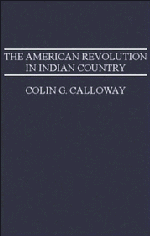Book contents
- Frontmatter
- Dedication
- Contents
- List of figures and maps
- Preface
- Acknowledgments
- Abbreviations
- Prologue New worlds for all: Indian America by 1775
- 1 Corn wars and civil wars: the American Revolution comes to Indian country
- 2 Odanak: Abenaki ambiguity in the North
- 3 Stockbridge: the New England patriots
- 4 Oquaga: dissension and destruction on the Susquehanna
- 5 Fort Niagara: the politics of hunger in a refugee community
- 6 Maquachake: the perils of neutrality in the Ohio country
- 7 Chota: Cherokee beloved town in a world at war
- 8 Tchoukafala: the continuing Chickasaw struggle for independence
- 9 Cuscowilla: Seminole loyalism and Seminole genesis
- 10 The peace that brought no peace
- Epilogue A world without Indians?
- Index
6 - Maquachake: the perils of neutrality in the Ohio country
Published online by Cambridge University Press: 18 December 2014
- Frontmatter
- Dedication
- Contents
- List of figures and maps
- Preface
- Acknowledgments
- Abbreviations
- Prologue New worlds for all: Indian America by 1775
- 1 Corn wars and civil wars: the American Revolution comes to Indian country
- 2 Odanak: Abenaki ambiguity in the North
- 3 Stockbridge: the New England patriots
- 4 Oquaga: dissension and destruction on the Susquehanna
- 5 Fort Niagara: the politics of hunger in a refugee community
- 6 Maquachake: the perils of neutrality in the Ohio country
- 7 Chota: Cherokee beloved town in a world at war
- 8 Tchoukafala: the continuing Chickasaw struggle for independence
- 9 Cuscowilla: Seminole loyalism and Seminole genesis
- 10 The peace that brought no peace
- Epilogue A world without Indians?
- Index
Summary
The image of the Shawnees in the historiography of the old Northwest has been not unlike that of the Apaches in the desert Southwest. Settlers on the frontiers of Pennsylvania, Ohio, Virginia, and Kentucky feared and hated the Shawnees even as they battled to take their lands, and the image of Shawnee warriors stalking frontier cabins proved too tempting for most later historians to abandon. The Shawnees' capture of Daniel Boone, their siege of Boonesborough, and their resolute resistance to American expansion would seem to suggest that their role in the American Revolution was clear, and certainly few tribes made such common cause with the redcoats.
The Shawnees, however, exemplify the inadequacy of standard portrayals of Indian experiences during the Revolution. Like other Indian peoples, they struggled to survive in a tumultuous situation not of their making. The revolutionary era brought a renewal and intensification of familiar pressures on Shawnee lands and culture; the Revolutionary War was one phase in a long and brutal contest for the Ohio River, in which the Shawnees occupied the front lines. As village chiefs from Chillicothe told the British in 1779, “We have always been the Frontier.” The Shawnees occupied a precarious position between the frontiers of Virginia and Kentucky and militant Mingo bands closer to Detroit. Tribes already allied to the British threatened to attack them if they contemplated peace with the Virginians. They became embroiled in the escalating conflict, but participation was never total, at least before the last year of the war. Different groups and individuals had different ideas about the best course to pursue. The American Revolution in Shawnee country translated into a story of political fragmentation and burning villages. Shawnee people struggled to hold their communities together in the midst of conflict and migration. In the case of the Maquachake division of the tribe, it was also a story of persistent efforts to live in peace, and of vain endeavors to maintain some kind of middle ground as militants on both sides created a new world of war.
- Type
- Chapter
- Information
- The American Revolution in Indian CountryCrisis and Diversity in Native American Communities, pp. 158 - 181Publisher: Cambridge University PressPrint publication year: 1995



